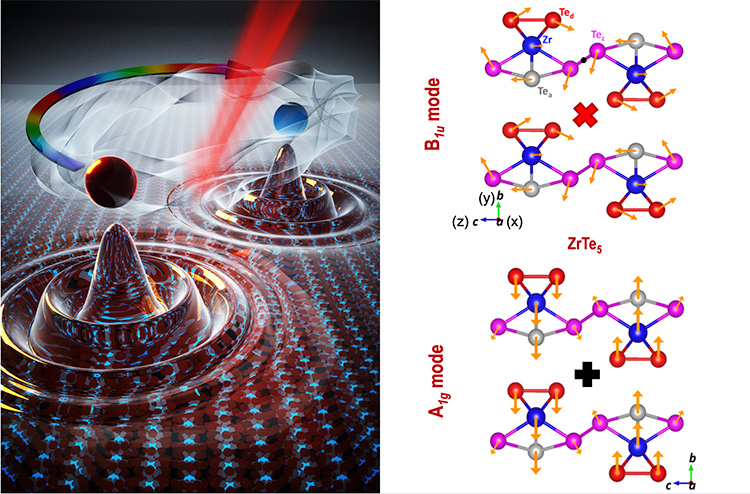 Left: Light-induced Weyl points in a Dirac material of ZrTe5. Right: Coherently twisted lattice motion of selective modes by laser pulses can control chirality and symmetry, and photogenerate giant low-dissipation topological photocurrents, with an exceptional ballistic transport topologically protected by the induced Weyl nodes.
Left: Light-induced Weyl points in a Dirac material of ZrTe5. Right: Coherently twisted lattice motion of selective modes by laser pulses can control chirality and symmetry, and photogenerate giant low-dissipation topological photocurrents, with an exceptional ballistic transport topologically protected by the induced Weyl nodes.
Quantum computing requires building devices that minimize energy dissipation and protect fragile quantum states from their noisy environments. One approach relies on light-induced, symmetry-protected topological photocurrents, which are theoretically immune to noise and enable chirality switching by quantum coherent motion with minimum energy loss.
Our group has developed a light-induced symmetry switch in which light twists the crystal lattice of a Dirac material with selective mode symmetry, coherently splits Dirac points to two pairs of Weyl points and photogenerates a giant low-dissipation current—with an exceptional ballistic transport protected by induced Weyl-band topology. We have demonstrated such light-driven topological control using both optical1 and terahertz2 pulses to drive coherent infrared and Raman phonons. These, in turn, induce a topological phase transition from Dirac to Weyl semimetal states in ZrTe5.
Experimental results and modeling show that two pairs of Weyl points can be dynamically created by light-induced mode-selective phonon pumping of broken inversion symmetry.1 Such phononic terahertz light control breaks new ground for coherent manipulation of Weyl nodes and robust quantum transport without application of static electric or magnetic fields. The discovery holds great promise for spintronics, topological-effect transistors and quantum computing.
We have applied polarized ultrafast photoexcitations to generate a chiral imbalance between the numbers of the right- and left-handed fermions in ZrTe5. The imbalance manifests as the photogeneration of giant anisotropic terahertz nonlinear currents with vanishing scattering in ZrTe5, driven by laser-induced coherent phonon oscillations of broken inversion symmetry in this centrosymmetric material. The temperature-dependent scattering rate of photocurrent appears nearly dissipationless towards low temperature. Berry curvature dominance marks the sharp suppression of impurity scattering due to chiral protection.
The strongly reduced scattering rate below 100 GHz, together with the large Fermi velocity (~c/300), leads to remarkably long ballistic mean free paths of ~10 μm for the photocurrent—more than one order of magnitude longer than in the topological insulator Bi2Se3. In addition, by selectively light-driving coherent Raman phonons, we also demonstrated topological switching using a few-cycle THz pulse in ZrTe5.2
We believe that these studies have opened a new arena of THz-speed topological modulation for ultrafast gating, addressing and switching by THz electromagnetic driving. Our results present a broader picture of light-driven quantum control of many-body complex systems, in which dynamic stability and quantum switching can be enabled by electron–phonon quantum kinetics and periodic lattice vibration driving of selective IR and Raman symmetries. The method can be extended to a broad range of complex materials, such as topological semimetals at THz-nm limit,3 topological insulators4 and superconductors5—all keys to developing superconducting quantum circuits and topological transistors.
Acknowledgment. This work was supported by the Ames Laboratory, the US Department of Energy, Office of Science, Basic Energy Sciences, Materials Science and Engineering Division under contract No. DEAC0207CH11358.
Researchers
Liang Luo and Jigang Wang, Ames Laboratory, U.S. Department of Energy, and Iowa State University, Ames, IA, USA
Ilias E. Perakis, University of Alabama at Birmingham, Birmingham, AL, USA
Genda Gu and Qiang Li, Brookhaven National Laboratory, Upton, NY, USA
References
1. L. Luo et al. Nat. Mater. 20, 329 (2021).
2. C. Vaswani et al. Phys. Rev. X 10, 021013 (2020).
3. R.H.J. Kim et al. ACS Photon. 8, 1873 (2021).
4. X. Yang et al. npj Quantum Mater. 5, 13 (2020).
5. C. Vaswani et al. Nat. Commun. 12, 258 (2021).

